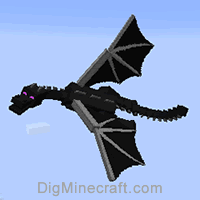NBT Tags for Ender Dragon in Minecraft (Java Edition 1.10)
This Minecraft tutorial explains the NBT tags (formerly called data tags) that you can use for an ender dragon in Minecraft Java Edition (PC/Mac) 1.10.
TIP: If you are not running Minecraft Java Edition (PC/Mac) 1.10, find NBT tags for ender dragon in another version of Minecraft:
Background
In Minecraft Java Edition 1.10, the entity value for an ender dragon is EnderDragon. The EnderDragon entity has a unique set of data tags that can be used in Minecraft commands such as: /summon, /entitydata, /give, /fill, /setblock, /testfor.

What are NBT tags (formerly called Data Tags)?
NBT tags allow you to set certain properties of an entity (such as EnderDragon). The NBT tag is always surrounded in {} such as {DragonPhase:7}. If there is more than one NBT tag used in a game command, the NBT tags are separated by a comma such as {DragonPhase:7, CustomName:Endie}.
List of NBT Tags
Here is a list of the NBT tags that you can use for EnderDragon in Minecraft Java Edition (PC/Mac) 1.10:
| NBT Tag | Value (Description) | Works With |
|---|---|---|
| DragonPhase | 0 (The dragon is starting its attack phase) Example |
/summon /entitydata |
| CustomName | name (The name to assign to the ender dragon. If the name has spaces, you need to surrounded the name value in "".) Example |
/summon /entitydata |
| Health | number (The number of health points the ender dragon has) Example |
/summon /entitydata |
| AbsorptionAmount | number (The number of absorption health points the ender dragon has) Example |
/summon /entitydata |
| Invulnerable | 0 (The ender dragon will take damage like normal) Example |
/summon /entitydata |
| PersistenceRequired | 0 (The ender dragon will despawn naturally) Example |
/summon /entitydata |
| NoAI | 0 (The ender dragon will have artificial intelligence and will move/behave like normal) Example |
/summon /entitydata |
| Silent | 0 (The ender dragon will make its usual noises in the game) Example |
/summon /entitydata |
| Fire | ticks (The number of game ticks until the ender dragon is no longer on fire - there are 20 ticks in a second) Example |
/summon /entitydata |
| PortalCooldown | ticks (The number of game ticks until the ender dragon can go through a portal again - there are 20 ticks in a second) Example |
/summon /entitydata |
| Air | ticks (The number of game ticks the ender dragon has air left for) Example |
/summon /entitydata |
| UUIDLeast | A number that specifies the right half of the UUID for the ender dragon (use UUIDLeast and UUIDMost to target/find a particular ender dragon in the game) Example |
/summon /entitydata |
| UUIDMost | A number that specifies the left half of the UUID for the ender dragon (use UUIDLeast and UUIDMost to target/find a particular ender dragon in the game) Example |
/summon /entitydata |
| id | EnderDragon (The entity value used to represent an ender dragon in the EntityTag or Passengers tag) Example |
/summon /give |
| Passengers | The mob that is riding on the ender dragon. Use the entity value for the passenger mob Example of skeleton as passenger |
/summon /entitydata |
NBT Tag Examples
To summon an ender dragon that is about to start its attack phase:
/summon EnderDragon ~ ~ ~ {DragonPhase:0}
To summon an ender dragon that is named Endie and is about to perform a breath attack:
/summon EnderDragon ~ ~ ~ {CustomName:Endie, DragonPhase:7}
To summon an ender dragon that is named Endie and is about to die and drop experience:
/summon EnderDragon ~ ~ ~ {CustomName:Endie, DragonPhase:9}
Target Selectors
Before we finish discussing data tags, let's quickly explore how to use the @e target selector. The @e target selector allows you to target entities in your commands. If you use the type=EnderDragon value, you can target ender dragons:
@e[type=EnderDragon]
You can also add a radius value to target ender dragons within a certain radius of blocks (for example, r=5 lets you target ender dragons within a 5 block radius of where the command is run):
@e[type=EnderDragon,r=5]
Target Selector Examples
To change all ender dragons to dragon phase 7 (perform a breath attack) within a 5 block radius:
/entitydata @e[type=EnderDragon,r=5] {DragonPhase:7}
To test for all ender dragons within a 50 block radius:
/testfor @e[type=EnderDragon,r=50]
To summon a lightning bolt at all ender dragons:
/execute @e[type=EnderDragon] ~ ~ ~ /summon LightningBolt
To kill all ender dragons:
/kill @e[type=EnderDragon]
Next, learn how to use the game commands in Minecraft.
Command Examples
Here are some game command examples for an ender dragon in Minecraft:
Command Generators
If you need help, you can use these tools to automatically generate commands for you:
Advertisements





